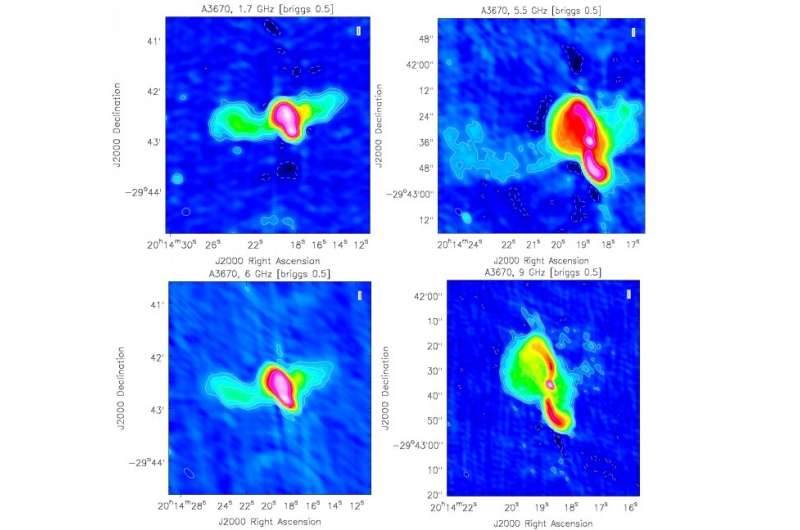October 24, 2019 report
Multifrequency observations shed more light on the nature of radio galaxy MRC 2011-298

Using Karl G. Jansky Very Large Array (JVLA), astronomers have performed multifrequency radio observations of the radio galaxy MRC 2011-298. Results of these observations, described in a paper published October 15 on arXiv.org, provide crucial information about the morphology and properties of MRC 2011-298, shedding more light on the nature of this galaxy.
Radio galaxies emit huge amounts of radio waves from their central cores. Black holes at the centers of these galaxies accrete gas and dust, generating high-energy jets visible in radio wavelengths, which accelerate electrically charged particles to high velocities. Depending on the lack or the presence of hotspots on the edges of their jets, astronomers divide radio galaxies into two classes, known as Fanaroff and Riley Class I (FRI), and Class II (FRII).
However, some radio galaxies showcase unusual morphology, having a pair of weak "secondary" lobes (also called "wings"), in addition to the bright "primary" lobes. Given that primary lobes host jets with hotspots while secondary lobes never host jets, and that the secondary lobes create an X-shaped structure, such unusual radio galaxies are dubbed X-shaped radio galaxies (XRGs).
MRC 2011-298 is the brightest cluster galaxy (BCG) of the Abell 3670 (A3670 for short) galaxy cluster located some 2.1 billion light years away. Previous observations of MRC 2011-298 have shown that it has a morphology resembling that of XRGs. In particular, the galaxy exhibits a pair of bright lobes in the north-south direction and a pair of weak lobes, or wings, in the east-west direction, oriented with an angle of about 90 degrees.
A team of astronomers led by Luca Bruno of University of Bologna, Italy, has took a closer look at MRC 2011-298. They conducted JVLA observations of Abell 3670 at 1.5, 5.5, 6, and 9 GHz, with the main aim of investigating the properties and origin of its candidate XRG.
"We performed new observations of the radio galaxy in A3670 with the JVLA at 1.5 (L-band), 5.5 (C-band), and 9 (X-band) GHz in CnB configuration, and at 6 (C-band) GHz in DnC configuration," the astronomers wrote in the paper.
The data from JVLA observations allowed the team to produce flux, spectral index and radiative age maps of Abell 3670. The study confirmed the absence of hotspots in the primary lobes of MRC 2011-298, while the spectral index maps revealed a steepening from the center to the outer regions of the galaxy.
The study found that that the wings of MRC 2011-298 are about 22 million years older than the lobes and that the mass of the galaxy's supermassive black hole is around one billion solar masses. The 1.4 GHz radio power of this source was estimated to be approximately 17 septillion W/Hz.
The astronomers concluded that the results of the study confirm the XRG nature of MRC 2011-298. Discussing the origin of this galaxy, the authors of the paper suggest that the jet-stellar shell interaction scenario is the most plausible one.
"Among the discussed scenarios, the jet-shell interaction model may best reproduce the observed properties of A3670. The gas of a stellar shell is responsible for the deflection of the jets, thus forming the wings," the scientists noted.
More information: Multifrequency JVLA observations of the X-shaped radio galaxy in Abell 3670, arXiv:1910.06568 [astro-ph.GA] arxiv.org/abs/1910.06568
© 2019 Science X Network





















